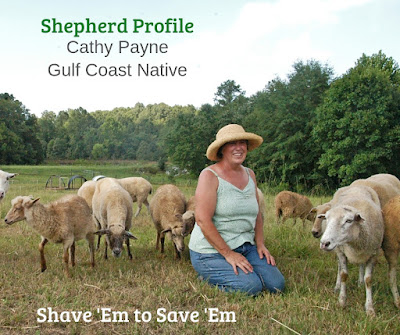Photo credit: James L. Hicks
Cathy Payne raised Gulf Coast Native sheep from 2011 to 2016 at Broad River Pastures in Elberton, Georgia, where she says, "summers are hot and humid. Winters are wet and mucky."
Why should a breeder sell the wool from their sheep?
If raising a heritage wool breed, it is important to make selection decisions based on the quality of the wool so you are knowledgeable about your flock and the value of the wool. If you do not select carefully, the quality of your wool will suffer. I raised Gulf Coast Native sheep which were used for handspun and hand knit clothing as early as the 1500s. While the wool can be processed at a mill, I chose to work with hand spinners. I discovered that the wool was very prized by them for its softness, ease of cleaning, and ease of spinning. I listened to their comments regarding sheen, crimp, staple, and color. I selected breeding lambs with those traits in mind and culled heavily for a meat market. I also took data on lambing, ease of lambing, mothering abilities, hoof health, and vulnerability to worms. I trained in Famacha so I wormed only as needed. Sheep that required worming more than once per year were culled. I learned out to skirt fleeces for better value to spinners and to get top dollar.Is it difficult to raise your sheep with an eye towards selling the wool? Why or why not?
Not at all. It added much joy to my flock. I did need to modify my hay feeder to avoid hay and seeds falling into the wool. However, living in the south I would never coat my sheep. It is too expensive anyway.Why have you chosen to sell your wool as raw fleece, roving, yarn, etc rather than in a different form? Or why have you chosen to do all of the above?
I sold the occasional fleece raw. However, I got more value trading to spinners. They would keep a portion of a fleece and return the remaining portion washed, dyed, and spun or washed and spun without dying. Some would make wool balls or soap sacks. It was more profitable for me to sell a finished product. More people knit than spin.What is one important thing you learned about sheep management as it relates to selling their wool?
See comments above about keeping fleeces clean and culling hard. Docking tails helps keep the hind fleece clean. Long tails and scours will make a mess. Bottle lambs have a higher incidence of scours.What is one surprising thing you learned about coating your sheep -- or having sheep that are not coated?
It can be a challenge to keep sheep clean but it is worth a minor effort.What is one important thing you learned about selling your wool?
Never under price, and market to people who appreciate a premium product. I got $16 a pound for fleece but $32 for 300 feet of 2 ply yarn, dyed. At shearing, I kept all fleeces separate and labeled by the name of the sheep. When I packaged fleeces or yarn, they were labeled with the name of the sheep. Some customers would contact me annually to purchase “Luna’s fleece” or "Luna’s yarn." It was also a novelty to sell soap in soap socks with the name of and photograph of the sheep. Premium pricing!Are you a Livestock Conservancy member who sells your wool? Want to share your experiences? Email Deborah with your answers to the above questions, and you may be featured in an upcoming post.




